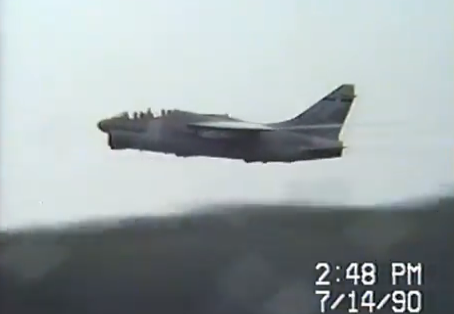A-7K strafe and extremely low fly by in the rain at the Grayling Air Gunnery Range.
Here’s an interesting clip from the Grayling Air Gunnery Range in Michigan on a rainy day on Jul. 14, 1990. Although it’s not the best quality (it was an old VHS video filmed by Chad Thomas from Jetwash Images, who converted and uploaded it to Youtube.com), it is a rather impressive as it shows low altitude strafing passes by an A-7K, few years before it was retired.
The Corsair (dubbed “SLUFF”, Short Little Ugly Fat Fellow) belongs to the 121st Tactical Fighter Wing Ohio ANG (OH), 162d Tactical Fighter Squadron, Springfield Air National Guard Base, Springfield, one of the last to fly the A-7.
The unit received the A-7D in 1978, received the two-seater A-7K in 1982 and eventually moved to the F-16 in May 1993.
As pointed out by our readers, the USAF operated the A-7D as a single seat (only) aircraft. There were no two seaters and all the training was done on the single seater with the IP (Instructor Pilot) on a chase aircraft. The Air National Guard (ANG) did the same when they got the aircraft in their inventory. Then, in the early 1980s, the ANG decided that having some two seat variants of the A-7D was a good idea. The ANG funded the production of a limited number of A-7D two seaters, which were named the A-7K: in total, 30 two-seaters were built. The school in Tucson got some to use in initial training, and each A-7D equipped operational ANG unit received at least one A-7K to add to its fleet, that was also used for VIP and media-orientation flights.








